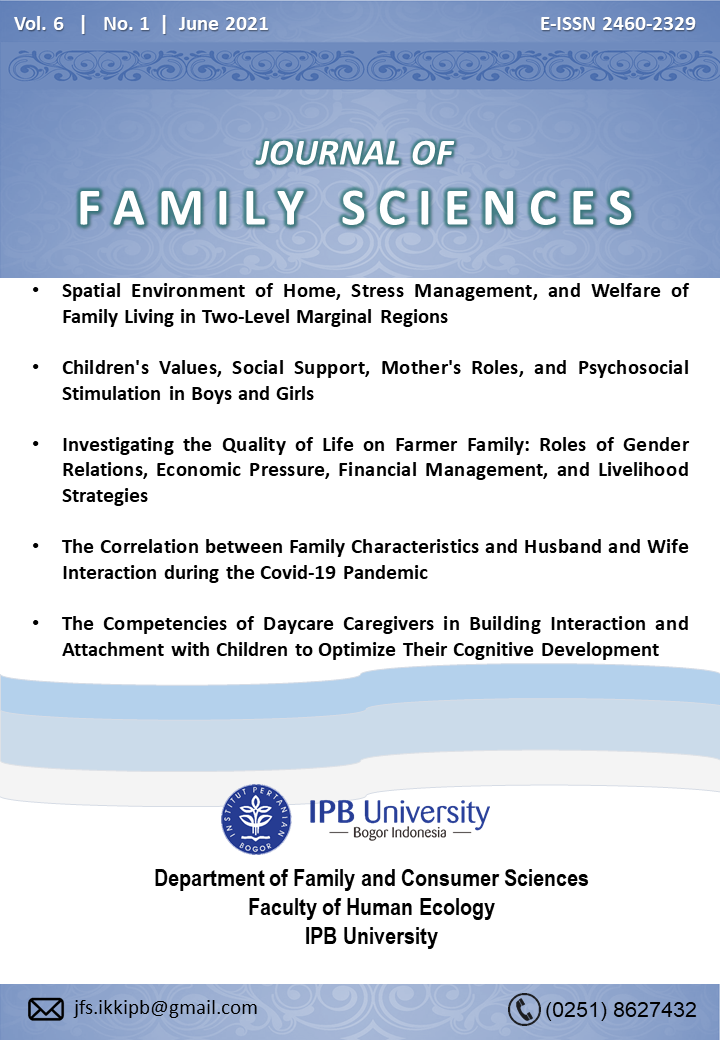The Correlation between Family Characteristics and Husband and Wife Interaction during the Covid-19 Pandemic
Abstract
Pandemics not only can facilitate a special space for husband-wife and child relationships but also a significant stressor for most husbands and wives and children. This study aimed to analyze the relationship between family characteristics and husband-wife interactions during the Covid-19 pandemic. This study used a cross-sectional study design and conducted in June-November 2020. The respondent in this study was a wife from an intact family who has elementary school–senior high school-age children (SD-SMA). The number of respondents in this study was 452 respondents. Data collection in this study was carried out using google form. Based on the research result, the highest means of index owned by the love dimension and the smallest index owned by respect's dimension. There are significant differences between HEL wife and LEL wife in love dimension, respect dimensions, and a total of husband-wife interaction. The correlation test shows that there is a significant negative correlation between husband's age, wife's age, and the number of children with husband-wife interaction. Furthermore, the correlation test also shows that the husband's income positively correlates with husband-wife interaction. This study concludes that women's higher education and husband's high income can make husband and wife interaction better.
Downloads
References
Aldous J. 1977. Family interaction patterns. Annual Review of Sociology. 3(1):105–135.doi: https://doi.org/10.1146/annurev.so.03.080177.000541
Anhusadar, L.A. (2020). Persepsi mahasiswa PIAUD terhadap kuliah online di masa pandemi COVID-19. Kindergarten: Journal of Islamic Early Childhood Education, 3(1), 44-58. doi: http://dx.doi.org/10.24014/kjiece.v3i1.9609.
Baernholdt, M., Yan, G., Hinton, I., Rose, K., & Mattos, M. (2012). Quality of life in rural and urban adults 65 years and older: findings from the national health and nutrition examination survey. The Journal of Rural Health, 1-9. doi: 10.1111/j.1748- 0361.2011.00403.x
Badan Pusat Statistik [BPS]. 2020. Tingkat Pengangguran Terbuka (TPT) sebesar 4,99 persen. Retrieved from https://www.bps.go.id/pressrelease/2020/05/05/ 1672/februari-2020--tingkat-pengangguranterbuka--tpt--sebesar-4-99-persen.html
Brown, S.M., Doom, J.R., Lechuga-Pe˜na, S., Watamura, S.E., Kopples, T. (2020). Stress and parenting during the global COVID-19 pandemic. Child Abuse & Neglect. doi: 10.1016/j.chiabu.2020.104699.
Eliana, N., & Ratina, R. (2007). Faktor-faktor yang memengaruhi curahan waktu kerja wanita pada PT. Agricinal kelurahan bentuas Kecamatan Palaran Kota Samarinda. Jurnal Ekonomi Pertanian, 4(2), 11-18. Retrieved from: http://agb.faperta.unmul.ac.id/academik/jurnal-ekonomi-pertanian-dan-pembangunan/
Gambin, et al. (2020). Factors related to positive experiences in parent-child relationship during the COVID-19 lockdown. The role of empathy, emotion regulation, parenting self-efficacy and social support. doi: 10.31234/osf.io/yhtqa.
Graber, E. C., Laurenceau, J.-P., Miga, E., Chango, J., & Coan, J. (2011). Conflict and love: Predicting newlywed marital outcomes from two interaction contexts. Journal of Family Psychology, 25(4), 541–550. https://doi.org/10.1037/a0024507
Hastuti, D. (2015). Pengasuhan: teori dan prisip serta aplikasinya di Indonesia. Bogor, ID: IPB Press.
Herawati, T., Kumalasari, B., Musthofa., & Tyas, F. P. S. (2018). Dukungan sosial, interaksi keluarga, dan kualitas perkawinan pada keluarga suami istri bekerja. Jurnal Ilmu Keluarga dan Konsumen, 11(1), 1-12. doi: 10.24156/jikk.2018.11.1.1.
Iversen, V., Jackson, C., Kebede, B., Munro, A., & Verschoor, A. (2011). Do spouses realize cooperative gains? Experimental evidence from rural Uganda. World Development, 39(4), 569-578.
Jeniu, E., Widodo, D. & Widiani, E. (2017). Hubungan pengetahuan tentang autism dengan tingkat kecemasan orang tua yang memiliki anak autisme di Sekolah Luar Biasa Bhakti Luhur Malang. Nursing News, 2(2), 32-42.doi: https://doi.org/10.33366/nn.v2i2.445
[Kemenkes] Kementerian Kesehatan. (2020). Pedoman kesiapsiagaan menghadapi Coronavirus Disease (COVID-19) Revisi ke-3. Jakarta (ID): Direktorat Jenderal Pencegahan dan Pengendalian Penyakit.
Larasati RN. (2013). Nilai-nilai keluarga, interaksi keluarga dan potensi perdagangan manusia (kasus di Kabupaten Cianjur) (skripsi). Institut Pertanian Bogor, Bogor, Indonesia.
Masturi, A. (2010). Membangun relasi sosial melalui komunikasi empatik (perspektif psikologi komunikasi). KOMUNIKA: Jurnal Dakwah dan Komunikasi, 4(1), 14-31. Retrieved from: http://ejournal.iainpurwokerto.ac.id/index.php/komunika/article/view/135
Mustajab, D., Bauw, A., Rasyid, A., Irawan, I., Akbar, M. A., & Hamid, M. A. (2020). Fenomena bekerja dari rumah sebagai upaya mencegah serangan COVID-19 dan dampaknya terhadap produktivitas kerja. TIJAB: The International Journal of Applied Business. doi: 10.20473/tijab.V4.I1.2020.13-21
Puspitawati, H. (2012). Gender dan Keluarga: Konsep dan Realita di Indonesia. Bogor (ID): IPB Press.
Puspitawati, H., & Setioningsih, S. S. (2011). Fungsi Pengasuhan dan Interaksi dalam Keluarga Terhadap Kualitas Perkawinan dan Kondisi Anak pada Keluarga Tenaga Kerja Wanita (TKW). Jurnal Ilmu Keluarga dan Konsumen, 4(1):11-20,DOI: http://dx.doi.org/10.24156/jikk.2011.4.1.1 1
Rachman, Y. A. (2019). Pengaruh Interaksi Suami-Isteri, Interaksi Orangtua-Anak, Interaksi Teman Sebaya, dan Resiliensi Remaja (Doctoral dissertation), Institut Pertanian Bogor, Bogor, Indonesia.
Rizkillah, R., Sunarti, E., & Herawati, T. (2015). Kualitas perkawinan dan lingkungan pengasuhan pada keluarga dengan suami istri bekerja. Jurnal Ilmu Keluarga & Konsumen, 8(1), 10-19.
Rustan, A. S. (2015). Menjalin Hubungan (Relation) dalam Perspektif Komunikasi Efektif. KOMUNIDA: Media Komunikasi dan Dakwah, 5(1), 78-90.doi: https://doi.org/10.35905/komunida.v5i1.80
Sholichah, N., & Anjarwati, R. (2015). Hubungan tingkat pendidikan dengan tingkat kecemasan wanita usia 40-50 tahun dalam menghadapi menopause. Jurnal Komunikasi Kesehatan, 6(20).Retrieved from: http://e-journal.akbid-purworejo.ac.id/index.php/jkk11/article/view/82/82
Sunarti, E., Rizkillah, R., Hakim, F. A., Zakiya, N., & Damayanti, R. (2021). Manajemen sumber daya keluarga, konflik kerja-keluarga, dan tugas keluarga. Jurnal Ilmu Keluarga & Konsumen, 14(1), 1-13.doi: https://doi.org/10.24156/jikk.2021.14.1.1
Tyas, F. P. S., Herawati, T. (2017). Kualitas pernikahan dan kesejahteraan keluarga menentukan kualitas lingkungan pengasuhan anak pada pasangan yang menikah usia muda. Jurnal Ilmu Keluarga dan Konsumen, 10 (1): 1- 12,DOI: http://dx.doi.org/10.24156/jikk.2017.10.1. 1
Waldinger & Schulz. (2006). Linking hearts and minds in couple interactions: intentions, attributions, and overriding sentiments. Journal of Family Psychology, 20(3): 494-504, doi: 10.1037/0893-3200.20.3.494
Wheatley, D. (2014). Travel to work and subjective well being: Astudy of UK dual career households. Journal of Transport Geography. 39: 187-196, DOI: https://doi.org/10.1016/j.jtrangeo.2014.0 7.009
Williamson, H. C., Karney, B. R., & Bradbury, T. N. (2013). Financial strain and stressful events predict newlyweds' negative communication independent of relationship satisfaction. Journal of Family Psychology, 27(1), 65–75. https://doi.org/10.1037/a0031104
Yoo, H., Bartle-Haring, S., Day, R. D., & Gangamma, R. (2014). Couple communication, emotional and sexual intimacy, and relationship satisfaction. Journal of sex & marital therapy, 40(4), 275-293.doi https://doi.org/10.1080/0092623X.2012.751072
Zhafirah, Z. (2020). Komunikasi Antarpribadi Pasangan Suami Istri Bahagia Studi Interaksi Simbolik pada Pasangan Suami Istri. Jurnal Penelitian dan Pengembangan Sains dan Humaniora, 4(2), 97-108.doi: 10.23887/jppsh.v4i2.27222
Zhang, X. (2012). The effects of parental education and family income on motherchild relationships, father-child relationships, and family environments in the people's republic of China. Journal of family Process, 51(4), 483-497.
Copyright (c) 2021 Journal of Family Sciences

This work is licensed under a Creative Commons Attribution 4.0 International License.
Authors who publish with this journal agree to the following terms:
- Authors retain copyright and grant the journal right of first publication with the work simultaneously licensed under

This work is licensed under a Creative Commons Attribution 4.0 International License. that allows others to share the work with an acknowledgement of the work's authorship and initial publication in this journal. - Authors are able to enter into separate, additional contractual arrangements for the non-exclusive distribution of the journal's published version of the work (e.g., post it to an institutional repository or publish it in a book), with an acknowledgement of its initial publication in this journal.
- Authors are permitted and encouraged to post their work online (e.g., in institutional repositories or on their website) prior to and during the submission process, as it can lead to productive exchanges, as well as earlier and greater citation of published work (See The Effect of Open Access).



_001.png)



